One of the problems you can encounter when traveling by car is a punctured tire. Using a patch is a fairly common option to work around this issue.
Yet, if the hole is in a position like a tire wall, the problem becomes much more complicated because it is likely that the defensive position will not be patched.
So, how close to the sidewall can a tire be patched? A distance of 6 mm or more from the tire shoulder is required to fit a patch. In other words, if a crack is closer than 6mm, there’s almost nothing you can do about it!
Tire Sidewall OverviewFirst, let’s learn about sidewalls and how to identify them on your tires.
The wall is the rubber part from the outer edge of the rim to the road surface. This part also has the largest area, is the most flexible, and continuously deforms under loads when moving.
How Close To Sidewall Can A Tire Be Patched?As you know, the car’s wall is in a particular location, so it is pretty challenging to troubleshoot the hole here.
Manufacturers also recommend that you not choose the patch option if the spot is on the side of the vehicle or too close to this position. Then, how close to the sidewall can a tire be patched.
You cannot use the patch if the hole is close to the wheel with a gap of less than 6mm. In addition, you should note that if the hole is more significant than ¼ inch, the patch should not be used. In this case, if the patch is small, it cannot cover the hole, causing the wheel to deflate still when moving.
On the contrary, using a large patch can make the wheel more bulky, difficult to move, and unsafe.
Fix Sidewall DamageOther Related QuestionsTo better understand the problems that occur with the tires and how to overcome them effectively, you can refer to the following information.
We’ve put together some frequently asked questions that may help answer your questions on this topic.
Plug a flat tire: Is it possible?People are often concerned about whether it is safe to plug or patch a flat tire.
These two options are pretty standard in repairing or overcoming the problem of flat tires caused by rolling nails or other sharp objects.
The manufacturer still recommends that you better replace the tire with a new one when there is a problem because repairing with a plug or patch when a flat one is not a safe solution.
Yet, the cost of new tires is not cheap, and if you have this problem often, it is a big problem. So, many drivers use a plug or patch when a wheel is punctured.
There is a limit to the number of nails or patches on a product. You can use this option to temporarily fix the problem if you find a few small holes. If the wheel has many large holes or previous patches, it is best to replace it with a new one.
For a detailed guide, check out this video:
How close can a tire patch be to another patch?The gap between patches is also a topic that people are very interested in. When traveling on the road, you may encounter a flat one many times.
As you know, when the tires have had previous patches or punctures in close locations, it is better to replace them. In case
Can you patch a tire on the side of the road?In the case of a puncture on the tire side, the use of stickers is unlikely to have as much effect as you think.
The reason is that its wall adhesion is so thin that relatively few materials can adhere. More specifically, damage to the sidewall will seriously damage the structure of a wheel.
More specifically, damage to the sidewall will seriously damage the structure of a wheel.
The solution to this problem is to insert an extra tube inside the wheel to ensure that you can still turn the whole thing.
How fast can you drive on a patched tire?A patched one will not achieve the same speed and performance as it once was. Therefore, the optimal level you can expect from such a version will not be more than 85 mph. Of course, this is just the limit that many manufacturers recommend, but you should not overdo this limit.
Can you patch a tire with 2 nails in it?The answer is yes! It’s just that the gap between the two punctures is at least 16 inches, and you might seal them with two large patches.
According to many manufacturers, the maximum number of times performed is two times. If more than that, it’s time to get a new one.
ConclusionAs such, a puncture in the side of the vehicle is a unique location where patching is not an optimal solution in this case. It would help if you changed to a new tire to ensure safety when traveling.
It would help if you changed to a new tire to ensure safety when traveling.
Thank you for following this post!
This post was last updated onPosted by Blair Lampe Know How
Your tires might not be the most complex part of your vehicle, but they’re arguably among the most indispensable. Keeping your tires in good condition is integral to both safety and performance, so when they suffer damage, it’s important to take care of it immediately. You’re likely familiar with patching tires, but are there limits to this practice? For instance, can you patch the sidewall of a tire?
Where the Rubber Meets the RoadTires have more going on than meets the eye. Over the years, tire technology has evolved to make them stronger, longer-lasting and safer in various driving conditions. There are many parts of a tire, but the two main external parts are the tread and the sidewall.
There are many parts of a tire, but the two main external parts are the tread and the sidewall.
The tread is what contacts the road. It’s very thick, it wears down over time, and it’s the part you pay special attention to when you’re watching out for alignment issues. It is meant to wear down, but evenly.
The sidewall is thinner because it is not designed to contact the road and wear down. It protects the inner plies of the tire, which are structural, and it flexes as the tire rotates and bears the weight of the vehicle.
Patching Your TiresMany people keep tire plug kits in their vehicles for emergency roadside repairs, but patches are a little more in-depth. In order to properly install a patch, the tire must be safely removed from the vehicle and the rim. The hole or tear area must be cleaned up and covered with vulcanized cement so that the patch can be installed from the inside and sealed before the tire is reinstalled on the vehicle.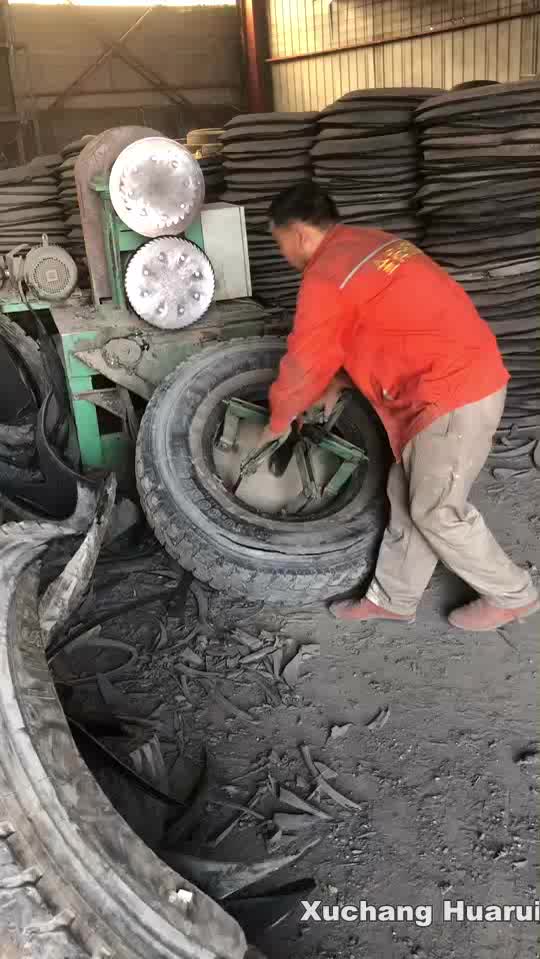
The patch adheres to the tire’s material around the damage, and the added pressure of inflation actually works to press the patch outward further plugging the hole. If done correctly, this creates a seal that can last the rest of the tire’s life. Patches are viable for repairing small holes or tears, generally, those that are 1/4 inch or less.
Fixing Damage in the SidewallIf you have a leak, hole or tear in your sidewall as opposed to your tread, you should not repair it with a patch. The thinness of the sidewall gives little material for a patch to adhere to, and the damage to the sidewall leaves the tire structurally compromised. As mentioned before, the sidewall tends to flex, putting extra stress on the repair and increasing the likelihood of patch failure, which is more likely to occur at higher speeds and pressures.
Patching the sidewall is simply not a good idea, as a leak or blowout while the vehicle is underway could result in loss of control with catastrophic consequences. So if you end up with a damaged tread, you can plug and patch away, but if the damage is to your sidewall, you’re going to have to replace the tire, which usually means replacing the fronts or rears in pairs.
So if you end up with a damaged tread, you can plug and patch away, but if the damage is to your sidewall, you’re going to have to replace the tire, which usually means replacing the fronts or rears in pairs.
So can you patch the sidewall of a tire? The answer is a solid no. Luckily, sidewall damage is far less common than damage to the tread, and you can minimize it by paying attention to road conditions, not overloading your vehicle, staying away from the curb when you’re parallel parking, and keeping your tires properly inflated, rotated and maintained.
Check out all the tires, wheels and accessories available on NAPA Online, or trust one of our 17,000 NAPA AutoCare locations for routine maintenance and repairs. For more information on patching tires, chat with a knowledgeable expert at your local NAPA AUTO PARTS store.
Photos courtesy of Blair Lampe.
Blair Lampe is a New York-based professional mechanic, blogger, theater technician, and speechwriter.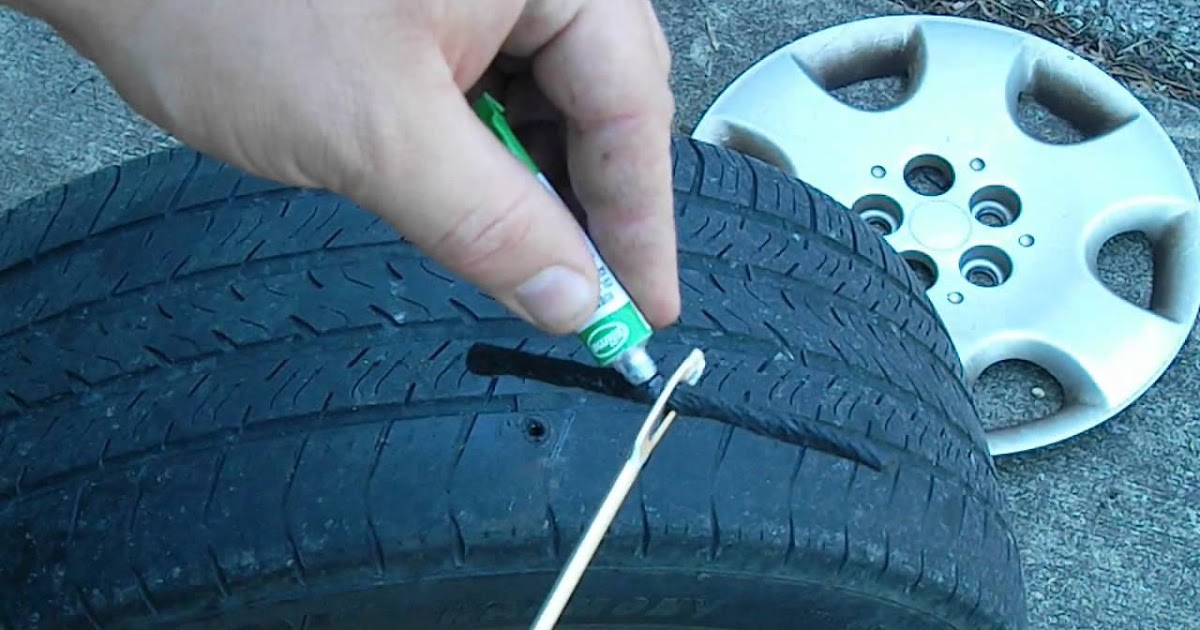 In her downtime she enjoys backpacking wherever her boots will carry her, rock climbing, experimental theatre, a crisp rosé , and showering love on her 2001 Sierra truck.
In her downtime she enjoys backpacking wherever her boots will carry her, rock climbing, experimental theatre, a crisp rosé , and showering love on her 2001 Sierra truck.
Author: Kirill Savchenko
“Chief, you've got ten minutes of work to do, the hole is nothing! Well, come up with something ... ”Every tire fitter has probably heard such words. Alas, not all tire damage can be repaired ...
But the situation can be reversed. A wheel pierced by protruding reinforcement may be repairable, while a small cut will write off the tire for scrap. Experienced tire fitters believe that it all depends on the point of damage and the object that caused it.
Experienced tire fitters believe that it all depends on the point of damage and the object that caused it.
Most often, drivers encounter punctures in the tread area of a tire. It is not always possible to detect it immediately. If in the days of tires and chambers the wheel lost pressure at the slightest puncture, then tubeless tires are much more reliable in this regard. A nail or self-tapping screw usually closes the puncture site, preventing air from escaping quickly.
With such a "plug" you can sometimes drive for months. The tire can lose pressure minimally without arousing suspicion. At the same time, an attempt to pull out a noticed nail on the way is likely to turn into a problem. In this case, the only recommendation is to pull out a foreign object only in a tire shop and repair the wheel.
In most cases, tread punctures are sealed either with special harnesses (some for temporary use, some for permanent use) or patches from the inside of the tire.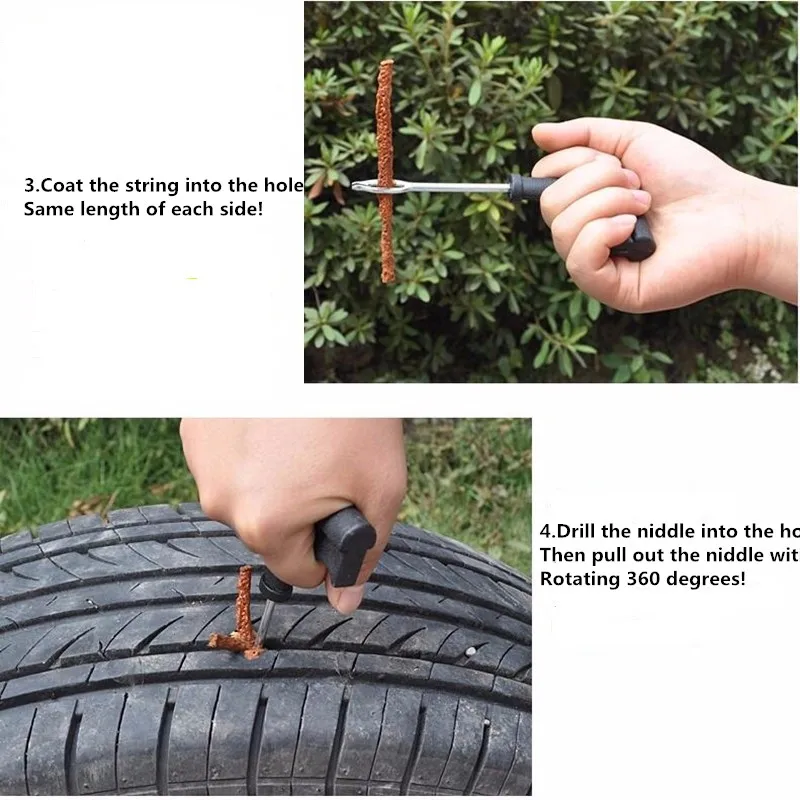 Even damage caused by massive pins can be repaired. The main thing is that a piece of the tire along with the cord is not torn out.
Even damage caused by massive pins can be repaired. The main thing is that a piece of the tire along with the cord is not torn out.
In the latter case, the hole is filled with raw rubber, vulcanized, and a special cord patch is placed on the inside. But this will only be a temporary measure. In addition, such repairs are not cheap, and purchasing a new tire can be both more profitable and safer.
In addition to the plaster, cord “fungi” are also used. Lubricated with glue, the “fungus” is inserted into the puncture from the inside of the tire, then the excess part of the “leg” is cut off from the outside.
On the other hand, a cord patch can seriously help with side cuts. And car owners meet with them quite often. But here there are several nuances. In a roadside tire shop, the cut will most likely not heal. You need to contact a company with specialized equipment, primarily vulcanization.
And one vulcanizer is not enough here. Cord patches should be with a certain number of layers, designed for strictly defined damage sites and of a suitable size. And again we are talking about the nuances.
And again we are talking about the nuances.
If the cut is in the shoulder area of the tire, then it is often impossible to repair it properly. The tire fitter who offered such a service is at great risk, even if he claims that he will weave a piece of new cord with his hands and vulcanize it. There are no miracles in this situation, but in any case, the last word belongs to an experienced specialist.
Low-profile tires with a tread height of less than 50% of the width are difficult to heal side cuts. That is why, in the case of using a car on roads with a possibility of tire damage, it is better to put those that are higher. They are much easier and cheaper to repair.
By the way, what appears to be a cut at first glance may not be one. If the sidewall of the wheel catches on something sharp, and a tear forms on the tire without damaging the cord, then this is called a pinch. It does not carry momentary danger and does not require any complex repairs.
However, if a piece of rubber remains, then it is glued with ordinary superglue.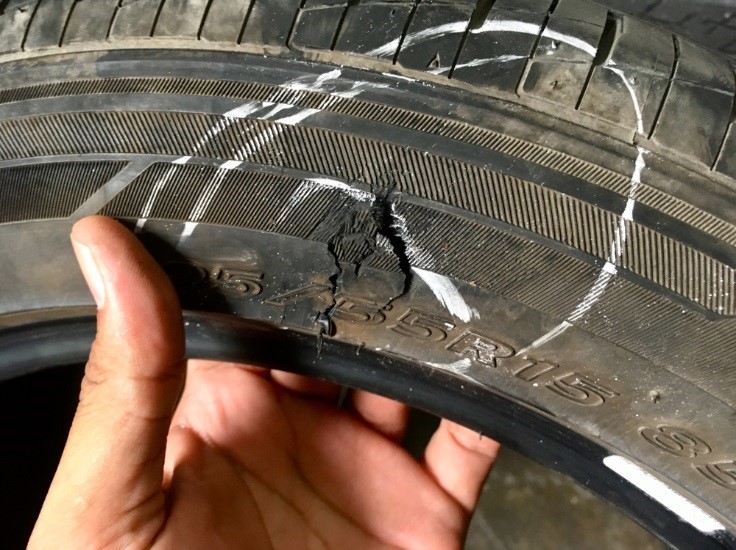 If not, you will need raw rubber and a vulcanizer. It is impossible to leave the cord bare: under the influence of moisture, it can collapse, which will lead to the complete loss of the tire.
If not, you will need raw rubber and a vulcanizer. It is impossible to leave the cord bare: under the influence of moisture, it can collapse, which will lead to the complete loss of the tire.
One of the most common and fatal tire defects is swelling or simply "herniation". Despite the absence of open damage to the rubber, such a wheel will be scrapped ahead of schedule. The fact is that when the sidewall is hit, the threads of the tire carcass break. Even if the swelling is very small, sooner or later the bump grows in size, and this is already fraught with an explosion of the wheel at speed.
However, some hernias can be repaired, but this is again a temporary measure. Masters can put cord patches even in the tread area. But only on condition that the distance from the sidewall to the swelling is more than 40 mm. If less, the tire is not subject to further operation. By the way, on low-profile tires, hernias, for the most part, are not repairable - both on the tread and on the sidewalls.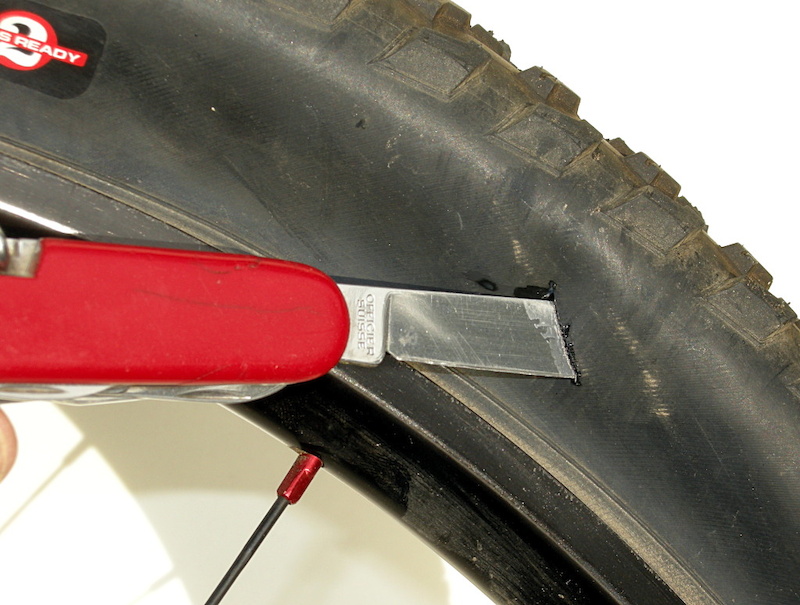
One of the major tire problems is caused by unprofessional repairs. Moreover, the owner most often does not know about it. We are talking about damage to the bead ring, as a result of which the tire does not initially hold the specified pressure.
Eventually the bead ring begins to push out of the rim. At high speed or under heavy load, such a wheel can be disassembled, which again threatens the car with a loss of control.
This damage can be repaired provided that the wire ring or base is not damaged. Special technologies for such repairs are not provided, but experienced craftsmen use the so-called "cold" or chemical vulcanization using a two-component sealant. The resulting mass covers places where there is no rubber on the bead ring. The main condition is to wait three days before mounting the tire on the disc.
As for Run Flat tires, according to the instructions of most manufacturers, they are not subject to repair. In extreme cases, you can use a bottle of special pressurized sealant that comes as a repair kit.
Comment of the expert of the company "SHINSERVICE":
Alexander Golubev
expert "SHINSERVICE"
First of all, we recall that most tire manufacturers do not recognize handicraft tire repair. It is considered a sign of external influence and changes in the design of the tire. Such a tire automatically voids the warranty. This does not happen if tire repairs are carried out in specialized, authorized tire brands services. Note that almost all major tire brands give their own extended warranty, according to which in most cases the repair is free, at a discount, or the product is generally replaced with a similar one, depending on the conditions of the program.
Based on our experience, we can note that in most cases damage in the bead area and in the shoulder area is not repairable.
I would also like to draw attention to the fact that most low-profile tires have high speed indexes (V and above), and even after professional repair they will not be able to be used in the previous modes without restrictions. Therefore, we strongly recommend changing the tire in all cases, except for tread punctures.
Therefore, we strongly recommend changing the tire in all cases, except for tread punctures.
practice tires and wheels
Articles / Popular questions Changes to the traffic rules for electric scooters of October 6, 2022: what has changed and when does it come into force Recently, we talked about what requirements are in the current traffic rules for those who ride electric scooters, and noted the imperfection of the legislation. After all, the drivers of most powerful e... 260 one 0 10/12/2022
Articles / Used cars 5 reasons to buy and not to buy Toyota Fortuner II “Impeccable car”, “phenomenal cross-country ability”, “shaky suspension, hard steering, the engine inside bellows like a buffalo”, “huge miscalculations in terms of comfort”, “comfortable handsome man”, “very . .. 3813 2 one 09.10.2022
.. 3813 2 one 09.10.2022
Articles / Practice Look into the kingpin: what is a kingpin suspension, how to maintain it and why to inject The word "pivot" today seems to someone as archaic as "zipun", "endova" and "batog". In fact, this is not so: the king pins have not left us yet, and it is likely that some will have to ... 1456 7 0 07.10.2022
Test drives / Test drive Haval Dargo vs Mitsubishi Outlander: the dog is barking, the stranger is coming In the Haval dealership in the south of Moscow, life is in full swing: buyers look at cars, communicate with managers and sign some papers.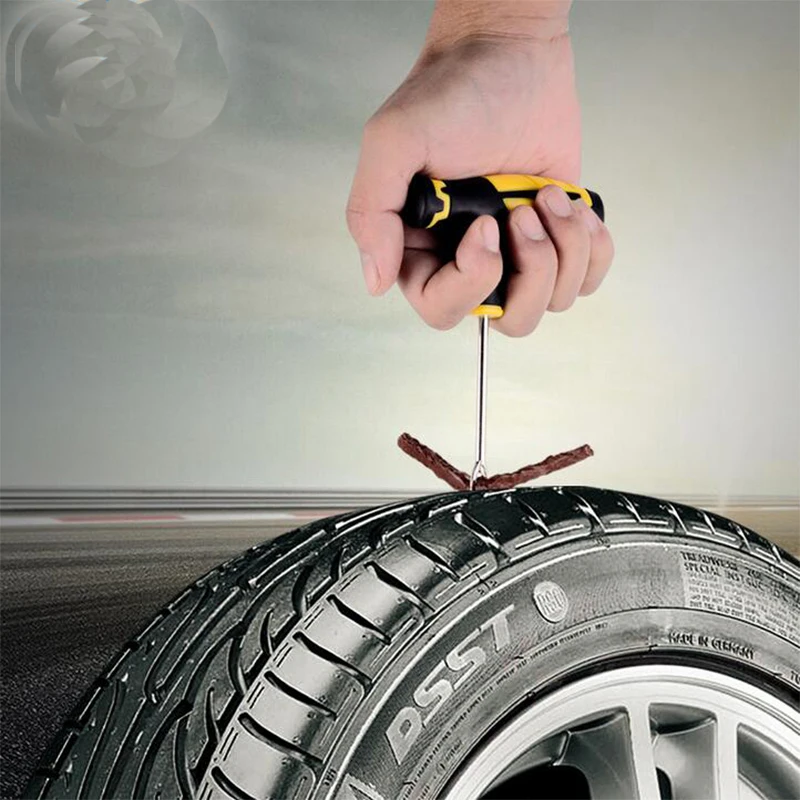 While I was waiting for the test Dargo, the same cross... 13108 7 16909/13/2022
While I was waiting for the test Dargo, the same cross... 13108 7 16909/13/2022
Test drives / Test drive Motor from Mercedes, emblem from Renault, assembly from Dacia: test drive of the European Logan 1.0 It would seem that what's new can be told about the second generation Renault Logan, known to every Russian taxi driver, as they say, up and down? However, this car has... 11449 ten 41 08/13/2022
Test drives / Test drive Geely Coolray vs Haval Jolion: Free Cheese? If! Do you want to buy a car today with a full warranty, on credit at an adequate rate, without wild dealer markups? Now this is still a task, because a full-fledged chain of "representation - s. .. 8373 25 thirty 08/10/2022
.. 8373 25 thirty 08/10/2022
In this article we will try to look deeper inside the tire. It is worth noting that there you can find a lot of interesting things. Moreover, anyone who wants to repair tire damage should at least in general terms know the internal structure of the tire.
Tires according to the type of construction are divided into radial and diagonal. If you look at the pictures, you can immediately see that tire construction is critical during puncture repair.
Comparing both figures, it is immediately clear that the sidewall thickness of a radial tire is very thin and is the thinnest point on the tire. From the point of view of repairing punctures, this is also the most difficult area, since it lends itself to strong bending loads.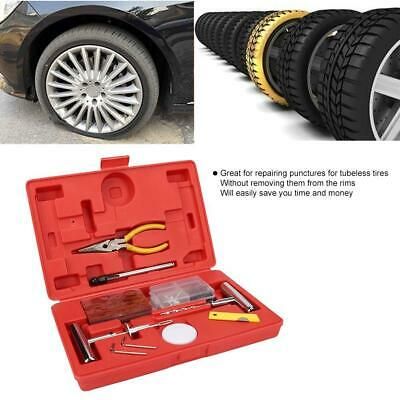 The loads that fall on the sidewall are concentrated only on a small number of cords. And if some threads, moreover, are damaged by a puncture, then we must very accurately and completely replace them with new threads, which are part of the repair patch.
The loads that fall on the sidewall are concentrated only on a small number of cords. And if some threads, moreover, are damaged by a puncture, then we must very accurately and completely replace them with new threads, which are part of the repair patch.
Radial tire sidewall repairs are the most time-consuming and complex of all tire repairs. Therefore, the following principles must always be remembered :
Principle 1: When the sidewall is punctured, the load-bearing cords are damaged and must be replaced with new ones during repairs.
Principle 2: The damaged area must first be cleaned and thoroughly repaired.
Principle 3: When applying a repair patch to a tire, the direction of the cord fibers in the patch must match the direction of the cord fibers in the tyre. Radial tires are patched from base to base, diagonal tires are patched to weave.
If you always follow these two main principles, puncture repair will become easier and more understandable.
Radial tires
Consider repairing a radial tire. On fig. 1 shows its main parts. Repairs can be carried out in the area of the working surface, the shoulder and on the sidewalls.
In the area of the bead area, repairs are prohibited, since in this section of the tire all load-bearing cords are attached to the bead area threads. This area plays a key role. Damage to the supporting structure in this area leads to the gradual destruction of the tire and is irreversible. Tires that have deep damage in this area are recommended not to be used again.
Radial tire sidewall puncture repair
Sidewall punctures are very common as radial tires are very thin and vulnerable.
Often the sidewall of radial tires consists of only one layer of cords. It is enough to inadvertently run into a curb, the edge of a pit on the road or tram tracks to get a break in the cords.
Shown in fig. 2, in addition to the main parts, also shows how the amount of damage on the sidewalls of a radial tire is estimated during its repair. These are two dimensions that are perpendicular to each other. Dimension A defines the width of the damage in the direction perpendicular to the cords. Dimension R means the length of the damage in the direction of the cords. Dimension A is very important because it indicates the number of cords damaged by the defect.
These are two dimensions that are perpendicular to each other. Dimension A defines the width of the damage in the direction perpendicular to the cords. Dimension R means the length of the damage in the direction of the cords. Dimension A is very important because it indicates the number of cords damaged by the defect.
How to correctly determine the amount of damage? It is not determined immediately, but during the repair, when all damaged and weakened parts of the cord threads are removed from the place of damage. At the same time, it is important to observe the main rule: everything that is weakened or delaminated must be eliminated, so that only cord threads that are securely connected to rubber remain in the area of damage. It often happens that a small, at first glance, damage after cleaning turns out to be a large defect. Also, during the repair process, it may turn out that the damage exceeds the allowable repair size in size and cannot be repaired. This is clearly seen in Fig. 3, 4, 5 and 6, when a large hole gradually appears in the area of damage.
3, 4, 5 and 6, when a large hole gradually appears in the area of damage.
The shape of the ground puncture on the sidewalls of a radial tire must be funnel-shaped, going at a minimum angle of 120°, as shown in fig. 7.
Good sanding of the damaged area is the key to a successful repair. It is worth noting that this particular stage of repair is most often carried out improperly. It must always be remembered that incomplete elimination of damaged material leads to the appearance of surfaces rubbing against each other. As a result of friction, heat is generated, which contributes to the gradual destruction of the tire material.
After cleaning, the sanded area of damage is filled with a repair rubber compound, as shown in fig. 8.
When gradually filling the hole with the rubber mixture, it is necessary to ensure that the tire material is completely connected to the filler. It is equally important to fill the damaged area with rubber in such a way that no air remains between the layers.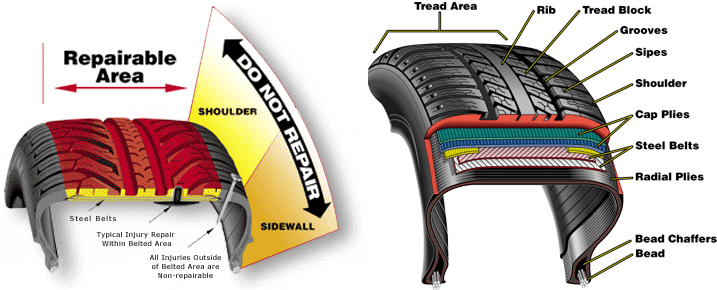
The damage treated and filled in this way must then be vulcanized with a vulcanizing clamp. It is important to ensure that the curing area is under pressure during the entire process. The pressure must be evenly distributed over the entire area of injury. Since the sidewall of the tire has an uneven thickness and a rounded shape, uniform pressure is achieved by investing special aluminum inserts shaped like the sides of the tire. For smaller repairs, instead of an insert, a bag of aluminum chips can be used, as shown in fig. 9. In this case, the bag is shaped like a tire. The disadvantage of this method is the need to increase the vulcanization time by approximately one hour, since aluminum chips conduct heat worse than a solid aluminum insert.
However, it is important to understand that vulcanization only achieves filling of the damaged area of the tire, but does not restore its load capacity. To restore the tire's ability to withstand loads, it is necessary to carry out the second stage of repair.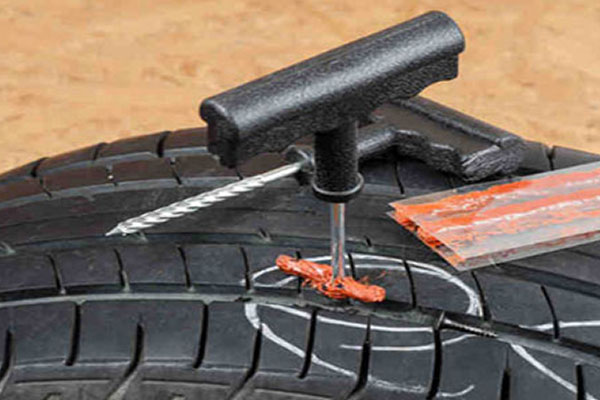 At this stage, it is necessary to cold-glue the supporting cord repair patch in the area of tire damage (Fig. 10). The use of such a patch makes it possible to restore the distribution of loads between the broken cord threads.
At this stage, it is necessary to cold-glue the supporting cord repair patch in the area of tire damage (Fig. 10). The use of such a patch makes it possible to restore the distribution of loads between the broken cord threads.
Before applying the patch, thoroughly sand the damaged area and apply a coat of curing mortar. This solution makes it possible to completely adhere the patch to the tire, since in most cases cold vulcanization is carried out. The curing solution contains ultra-accelerators which, when in contact with the gauge bonding material of the patch, promote the conversion of monomer to polymer. That is, the process of chemical vulcanization occurs at ordinary temperature. The size of the repair patch is selected according to the manufacturer's table, depending on the size of the damage. In this case, the rule applies that the middle of the patch is placed in the center of the damage.
Repair of punctures in the running surface of a radial tire
In general, repairing the running surface area is similar to repairing sidewalls.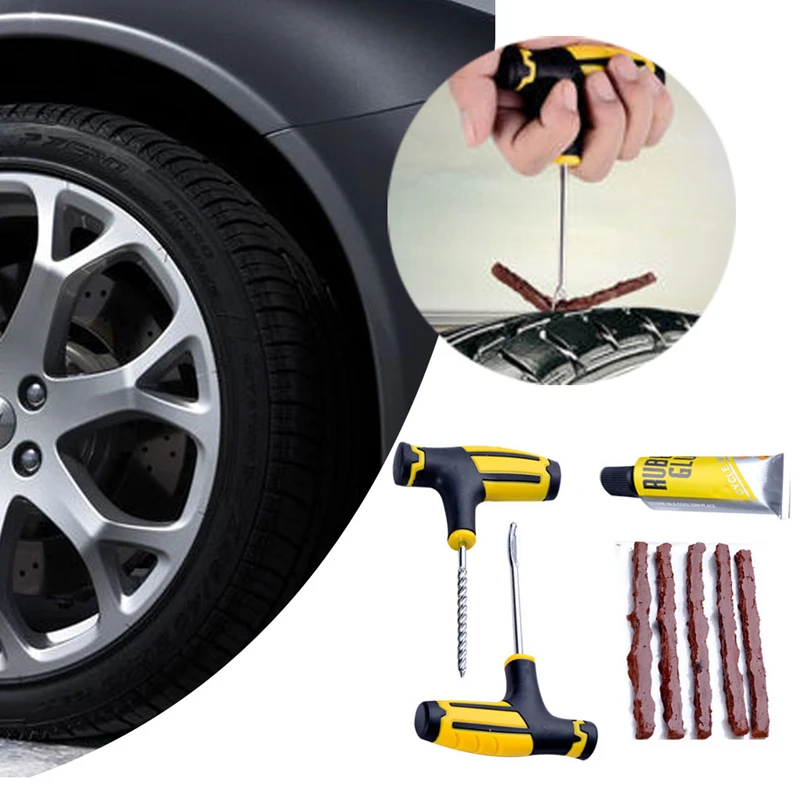 However, the running surface area is not as thin as the sidewall, so there are a few things you need to be aware of when repairing this part of the tire. First of all, the funnel shape of the ground hole should have a smaller angle of approximately 90°. But it is still important to completely eliminate all parts of the weakened cord. In the area of the working surface, the tire is much more powerful, because in addition to the carcass cords, there is also a powerful reinforcing buffer belt. This must be taken into account when assessing the magnitude of damage (Fig. 11). After removing all loose cords and grinding to the desired funnel shape, it is necessary to measure the dimension A - the width of the carcass damage in the direction perpendicular to the cord. At the same time, dimension C is measured - the largest diameter of the damage to the reinforcement belt. Whichever of these two parameters is larger should be used to determine the damage width. Dimension R is used to determine the length of the damage.
However, the running surface area is not as thin as the sidewall, so there are a few things you need to be aware of when repairing this part of the tire. First of all, the funnel shape of the ground hole should have a smaller angle of approximately 90°. But it is still important to completely eliminate all parts of the weakened cord. In the area of the working surface, the tire is much more powerful, because in addition to the carcass cords, there is also a powerful reinforcing buffer belt. This must be taken into account when assessing the magnitude of damage (Fig. 11). After removing all loose cords and grinding to the desired funnel shape, it is necessary to measure the dimension A - the width of the carcass damage in the direction perpendicular to the cord. At the same time, dimension C is measured - the largest diameter of the damage to the reinforcement belt. Whichever of these two parameters is larger should be used to determine the damage width. Dimension R is used to determine the length of the damage.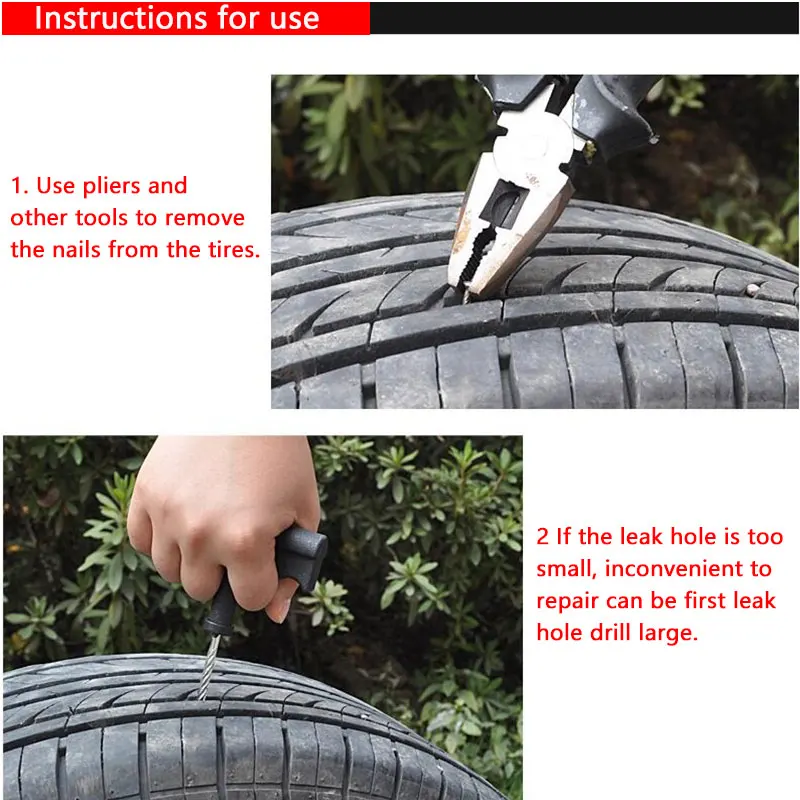 All measurements A, C and R are taken from the inside of the tire.
All measurements A, C and R are taken from the inside of the tire.
After this, the repair procedure is identical to repairing the tire sidewall. The sanded area is filled with a repair rubber mixture, as shown in Fig. 12. When gradually filling, it is necessary to ensure that the filler material is completely connected with the tire material. It is equally important to carry out the filling in such a way that no air remains between the layers.
The damage thus treated is then vulcanized using a clamp (fig. 13) and a repair patch is applied. The size of the repair patch is selected in accordance with the manufacturer's table, depending on the size of the damage.
Bias tires
Bias tires are inherently more powerful and less vulnerable than radial tires. Bias tires are used less and less today. Most often they are installed on agricultural and loading equipment. Since these tires work in harsh conditions, they are more likely to have punctures.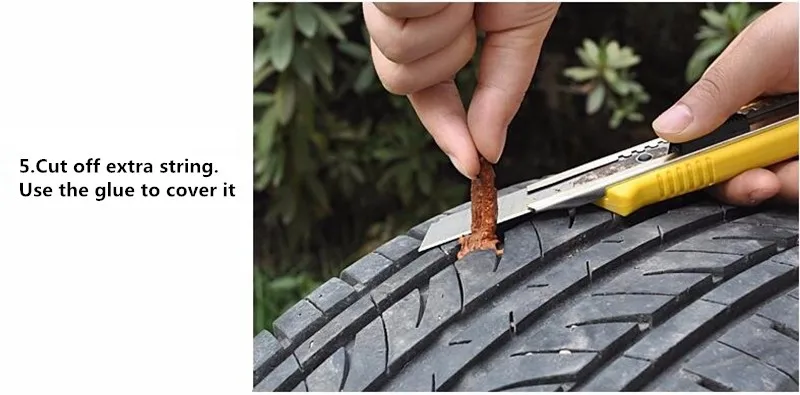 Bias tires are easier to repair than radial tires because they have thicker sidewalls. The cutting and grinding angles of the damaged areas on the main parts of the tire are shown in fig. 14. On the sidewalls - 90°, and in the area of the working surface - 60°. As with radial tyres, it is forbidden to repair the bead area of bias tyres.
Bias tires are easier to repair than radial tires because they have thicker sidewalls. The cutting and grinding angles of the damaged areas on the main parts of the tire are shown in fig. 14. On the sidewalls - 90°, and in the area of the working surface - 60°. As with radial tyres, it is forbidden to repair the bead area of bias tyres.
Repair of sidewall and running surface punctures on bias tires
The procedure for repairing damaged cords and rubber material is the same as the repair procedure described for radial tires. But in this case, it is very important that no unremoved residues remain in the area of damage. The size of the repair patch is determined by the size of the damage to the cord threads C (Fig. 15) and is selected according to the manufacturer's table. The method of filling the damage with a repair mixture is shown in Fig. 16. Vulcanization is carried out using a vulcanization clamp. Diagonal patches are also used as radial patches.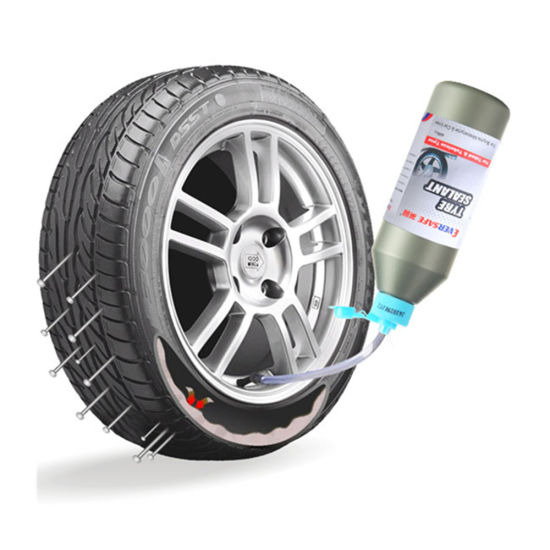 The main requirement: the middle of the patch should be placed in the middle of the damage (Fig. 17, 18).
The main requirement: the middle of the patch should be placed in the middle of the damage (Fig. 17, 18).
Bias patches are larger than radial tire patches. Therefore, diagonal patches intended for repairing sidewalls should have a “notch” with a radius of the side zone in the area of the bead zone, as shown in Fig. 18.
Tire puncture repair, based on this article, may seem quite complicated. In fact, this is not at all the case. It is sufficient to observe several basic rules :
1. All damaged and delaminated cords and rubber material must be removed at the puncture site.
2. Puncture should be ground into a funnel shape with the following angles:
- Radial sidewalls - 120°
- Radial worktop - 90°
- Diagonal sidewalls - 90°
- Diagonal worktop - 60°.
3. The defect must be filled with a quality rubber compound.
There must be no air between the layers.
4. Vulcanize the filling area.
5.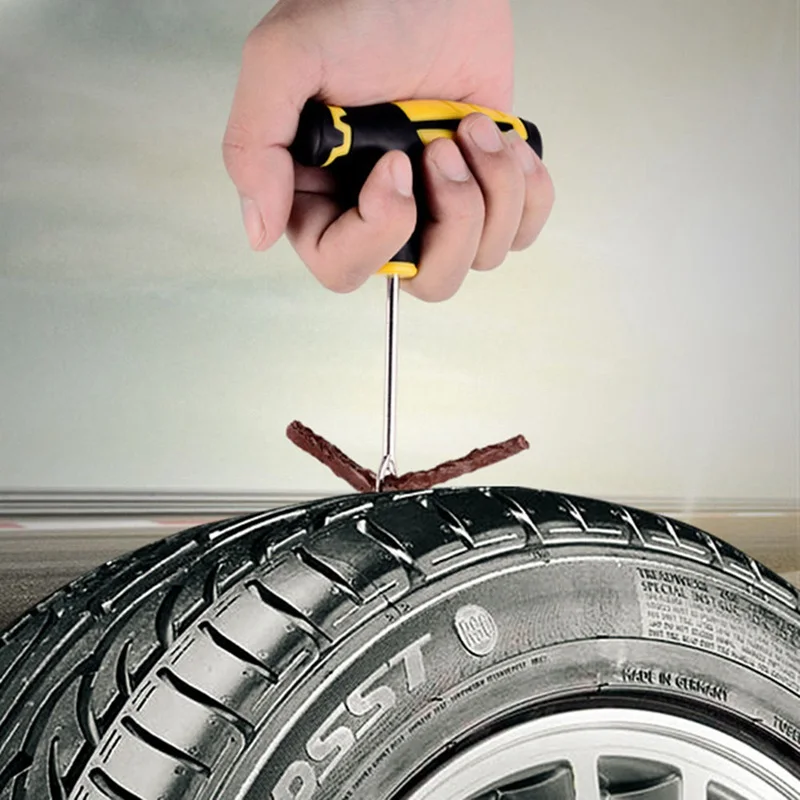 According to the dimensions of the puncture, after grinding it, select the repair patch of the required size according to the manufacturer's table.
According to the dimensions of the puncture, after grinding it, select the repair patch of the required size according to the manufacturer's table.
6. Cold bond a quality repair patch to the damaged area using a quality curing solution. The center of the damage must match the center of the patch.
7. Finish and check the quality of work. It is important to remember that each manufacturer of repair materials has its own developed technological procedure for repairing tire punctures and its own tables, according to which the appropriate repair patches should be selected.
Thus, there are quite a lot of technologies and materials for high-quality puncture repair. In conclusion, this article is not meant to be a textbook on tire repair, as we have covered only the most basic types of puncture repairs here to give the reader a general idea of them. In this article, we have omitted the topic of tire shoulder puncture repair as it is similar to tire sidewall repair.